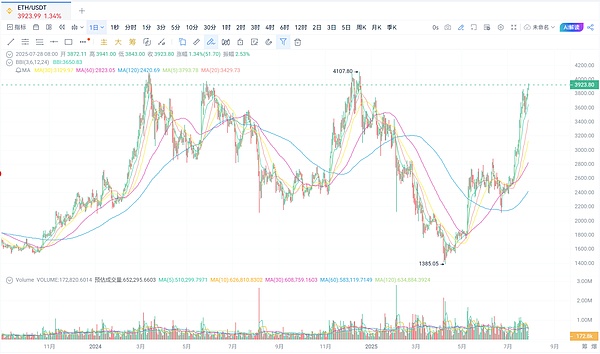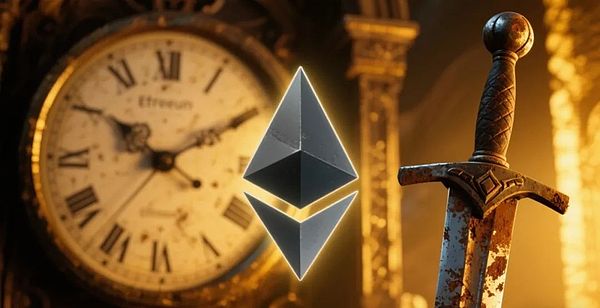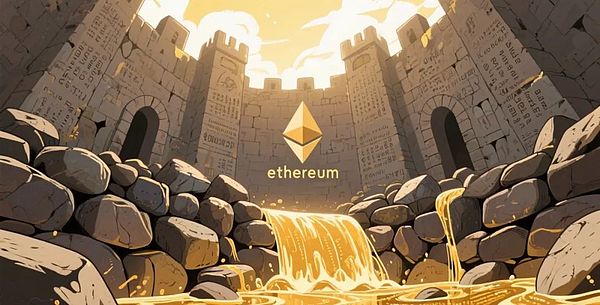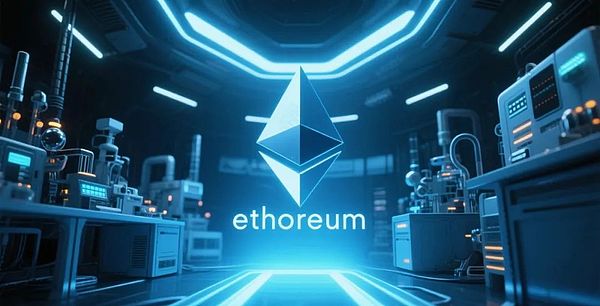Author: Mask
A Decade of Ups and Downs: A Glamorous Transformation of Digital Assets
On July 30, 2025, Ethereum's genesis block will celebrate its 10th anniversary. In 2013, 19-year-old Vitalik Buterin wrote in the white paper: "Blockchain should not only keep accounts, but also run programs." At that time, Bitcoin enthusiasts scoffed: "Is this kid just being overly dramatic?"

Fast forward ten years, this "overly dramatic idea" has grown into a behemoth with a market value of nearly $500 billion:
In 2015, the mainnet launched: the code had so many vulnerabilities it was like a "sieve," miners complained while mining;
In 2016, the DAO incident: hackers stole $50 million, the community hard-forked to save the situation, splitting off "Ethereum Classic" (ETC);
In 2022, the "Merge" upgrade: abandoning energy-consuming mining machines, switching to an eco-friendly staking mechanism, energy consumption plummeted by 99.95%;
In 2024, ETF approval: Wall Street opened its doors, BlackRock and others entered the market with cash in hand…
Looking back now, this is not just blockchain; it is clearly a hardcore entrepreneurial history of a group of idealistic geeks — each crisis felt like a game boss battle, leveling up upon victory.
Just last week, a fund manager friend of mine, who used to only buy gold, messaged me: "Help me buy some Ethereum, but don't tell my mom." Institutional investors are flooding into Ethereum at an unprecedented pace, with listed companies like BitMine and Sharplink Gaming hoarding over 1.3 million ETH, worth billions of dollars — it seems like a gold rush of the digital age is unfolding.
1. Price Roller Coaster: The Bull Market Engine Has Ignited
The Ethereum market in the past six months has been more thrilling than a roller coaster.

In April's darkest moment, ETH briefly fell below $1,500, plummeting 65% from the historical high of December 2024. At that time, the trading group by my coffee cup was eerily silent, with some even discussing the possibility of switching to food delivery.
However, the counterattack in July caught everyone off guard. In just one month, the price of ETH soared from $2,551 to $3,707 (as of July 24), a nearly 50% increase. Even more astonishing was the ETH/BTC exchange rate, which surged 36% in a month, as Ethereum finally broke free from Bitcoin's shadow and began to chart an independent course.
Now standing at the $3,900 mark, the entire crypto circle is holding its breath: when will the psychological barrier of $5,000 be breached? Galaxy Digital CEO Mike Novogratz's prediction represents the voice of many: "ETH is destined to challenge $5,000, and once it breaks through, it will enter a price discovery mode."
Analysts' predictions range from a conservative $4,308 (average of Finder expert group) to an aggressive over $8,000. When I saw Eric Trump publicly support the view that "ETH should exceed $8,000" on Twitter, I realized: the narrative around Ethereum has completely changed.
2. A Decade of Transformation: From Smart Contracts to Financial Infrastructure
Looking back at Ethereum's evolution is like watching a technological financial evolution:
2015-2019: Idealistic Testing Ground
The concept of a "world computer" in the white paper amazed the world, but the congested network and sky-high gas fees could even paralyze the CryptoKitties game; at that time, ETH felt more like a geek's toy.
2020-2022: The Engine of the DeFi Revolution
Decentralized applications like Uniswap and Aave exploded, making Ethereum the foundation of financial Lego blocks, completing a glamorous transition from energy-consuming proof of work (PoW) to energy-efficient proof of stake (PoS).
2023 to Present: The Rise of Institutional Assets

Why is Ethereum called the "Android of the blockchain world"?
Bitcoin is like Nokia: it can only make calls and send texts; Ethereum, however, is like Android: anyone can develop apps. Where is its competitive moat?
- The ecosystem has become "the water, electricity, and coal of the digital economy"
- DeFi (Decentralized Finance): Uniswap's daily trading volume rivals half of the Shanghai Stock Exchange;
- NFT (Digital Assets): Bored Apes sell for $1 million, even Jay Chou collects them;
- Stablecoin Dominance: 80% of USDC and USDT run on Ethereum, with an average daily settlement of $12 billion…
- Technological upgrades are like "installing rocket engines on highways"
- Sharding technology will be implemented in 2025: transaction speed will increase from 15 transactions per second to 100,000, and transaction fees will drop from $10 to $0.001;
- zkEVM launch: privacy computing makes on-chain transactions more confidential than Swiss banks, with Goldman Sachs lining up to enter;
- Staking thresholds plummet: in the future, using 1 ETH (about $3,000) will allow you to become a "blockchain shareholder," earning 6-8% annual returns effortlessly.
- Policy "Green Light" Effect
The U.S. Congress passed the CLARITY Act, recognizing ETH as a commodity rather than a security; the GENIUS Act brought on-chain stablecoins under regulation — compliance equals a ticket for institutions to enter.
When BlackRock issues the BUIDL fund on Ethereum, and JPMorgan launches deposit tokens on Base L2, traditional financial giants are voting with real money — Ethereum has officially upgraded to financial infrastructure.
The most critical shift has occurred in the value storage domain. Over 33 million ETH have been staked (accounting for about 26% of the circulating supply), combined with the EIP-1559 burning mechanism, forming a deflationary spiral, compressing its annual inflation rate to below 1.5%, even lower than the gold mining rate. As fiat currencies continue to dilute purchasing power due to policies like the "Too Big to Fail" act, this digital scarcity becomes particularly precious.
3. Four Engines Igniting Ethereum's Value Explosion
The current fundamentals driving Ethereum form a solid value support network:

Engine One: "On-chain Treasury Bonds" for Corporate Treasuries
Latest data shows that ETH reserves in the treasuries of listed companies have surpassed 730,000. The Ether Machine even plans to go public with 400,000 ETH, viewing ETH as a strategic reserve asset for generating income, much like a country holding gold reserves.
Engine Two: ETFs Open the Institutional Floodgates
Since the approval of the spot ETF in July 2024, net inflows of institutional funds have reached $4.2 billion. Even more shocking, Ethereum ETFs have seen inflows surpassing Bitcoin ETFs for seven consecutive days. Once the traditional financial faucet is turned on, the flood of funds is unstoppable.
Engine Three: RWA as Value Anchors
The tokenization of real-world assets is creating a market worth $16 trillion. Currently, over 70% of on-chain RWA issuance occurs on Ethereum and its Layer 2 networks. When industry giants like BlackRock and Franklin Templeton choose to issue tokenized funds on Ethereum, its "financial layer" status is firmly established.
Engine Four: Technological Upgrades Reduce Costs and Increase Efficiency
The Pectra upgrade in May 2025 was like giving Ethereum a new engine: smart contract efficiency improved, Layer 2 transaction costs plummeted, and the gas fee issues that once troubled developers are being resolved by modular architecture and L2 solutions.
4. Dual Sovereigns Compete: A New Order on the Public Chain Battlefield
As Solana attracts meme coin enthusiasts with low transaction fees (BONK's market cap has exceeded $2.6 billion), some begin to question Ethereum's dominance. However, a closer look reveals that the two public chains are developing distinctly different ecological niches:

Ethereum = Financial Hub: It occupies an absolute share of 61% of the total locked value (TVL) in DeFi across the network, becoming a "safe vault" for high-value asset issuance.
Solana = Consumption Paradise: It supports high-frequency trading scenarios with extreme speed and low costs, becoming a "traffic playground" for meme coins and social applications.
Grayscale continues to increase its ETH holdings as ETF reserves, while Jump Trading is heavily investing in the SOL ecosystem — capital is voting with real money to create a "dual-track" structure. This is akin to the serious investment banks on Wall Street versus the noisy billboards in Times Square, each having its own value.
But when I see Ethereum developers maintaining a monthly active user base of 50,000 (four times that of Solana), I understand: the gathering place for innovative talent is the true moat of blockchain.
For the average person, my observation framework is:
Risk Buffer: Experts predict a potential pullback to $1,940 in 2025, ensuring you can withstand fluctuations of over 30%.
Value Metric: Pay attention to on-chain stablecoin reserves (currently $131 billion, doubling in recent months) and the ETH market cap ratio; a 3.4x indicator suggests ETH may be undervalued.
Time Leverage: If you believe in long-term predictions of $10,882 in 2030 and $22,374 in 2035, short-term fluctuations are just ripples.
Crypto analyst Wolf's roadmap is the most practical: "After breaking the historical high, a 20-25% pullback will occur, which is the last opportunity to buy the dip." True opportunities often lie hidden in the depths of collective panic.
I recall Vitalik Buterin's words from ten years ago: "What we are building is not a tool, but the infrastructure of a new economy." Turning around, I see several suited investment bankers passionately discussing the ETH staking yield curve — at this moment, idealism has finally shone through into reality.
Over the past decade, Ethereum has transformed from a geek's toy into a corporate treasury. When listed companies include ETH on their balance sheets and Federal Reserve officials begin referencing the Ethereum white paper, the outcome of this social experiment is already clear.
If you believe that the digital world will ultimately reconstruct reality — then Ethereum is the infrastructure madman holding the blueprint.
免责声明:本文章仅代表作者个人观点,不代表本平台的立场和观点。本文章仅供信息分享,不构成对任何人的任何投资建议。用户与作者之间的任何争议,与本平台无关。如网页中刊载的文章或图片涉及侵权,请提供相关的权利证明和身份证明发送邮件到support@aicoin.com,本平台相关工作人员将会进行核查。




